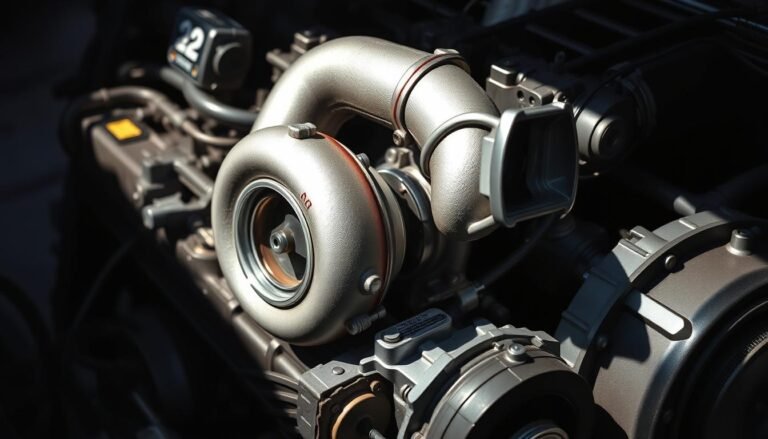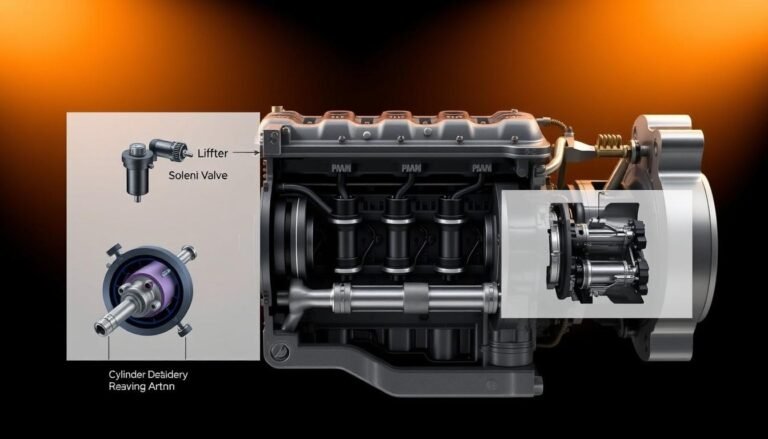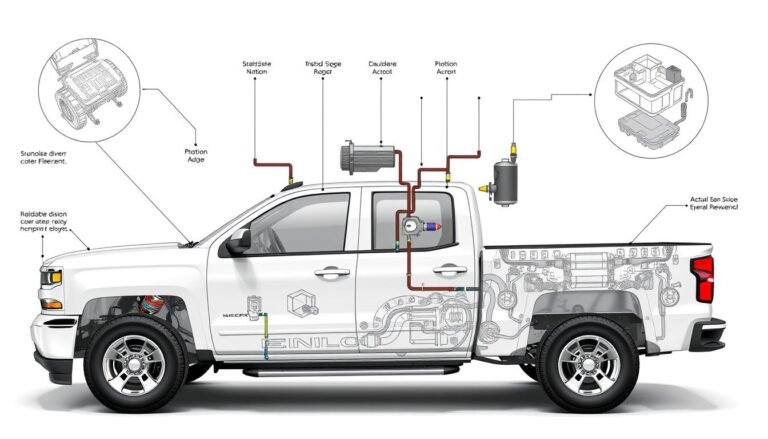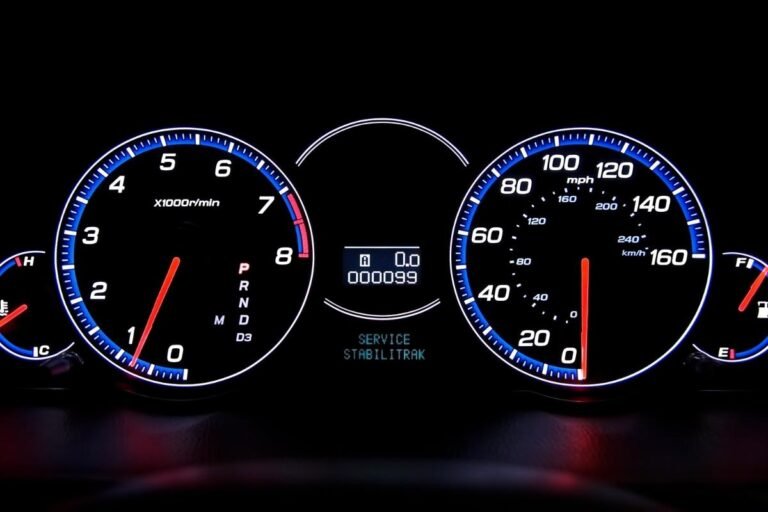Silverado Tire Pressure Sensor Problems
Having problems with your Silverado’s tire pressure sensors can affect your truck’s performance and safety. The TPMS system checks tire pressure and warns drivers of any issues. This helps avoid serious safety problems.
Many Chevrolet Silverado owners face TPMS problems, from simple battery issues to complex sensor failures. Replacing a sensor costs about $98, mostly due to labor. A lit TPMS warning light often signals a sensor problem.
It’s key to understand these TPMS issues to keep your Silverado safe and running well. This guide will help you with diagnostics, replacements, and how to manage your truck’s tire pressure system.
TPMS Systems in Chevrolet Silverado
Tire Pressure Monitoring Systems (TPMS) have changed vehicle safety, like in Silverado TPMS systems. These smart systems give vital info on tire health and dangers. GM’s advanced tire monitoring technology keeps drivers updated on their tires.
Direct vs Indirect TPMS Systems
The Chevrolet Silverado mainly uses direct TPMS, which is better at monitoring. It has sensors in each wheel for real-time pressure readings. These sensors send exact data to the car’s computer, spotting pressure changes right away.
- Direct TPMS: Sensors in each wheel
- Indirect TPMS: Uses wheel speed sensors
- More accurate pressure monitoring
Evolution of TPMS Technology
TPMS tech has improved a lot, starting from 2007. Today’s Silverado TPMS systems have better sensors, including:
- Improved battery life (up to 10 years)
- More frequent pressure sampling
- Advanced data transmission
How Silverado TPMS Sensors Function
Silverado TPMS sensors work with great accuracy. Each sensor checks pressure every 30 seconds. If pressure changes by more than 1.2 PSI, the system checks again right away to keep drivers safe.
| TPMS Feature | Specification |
|---|---|
| Measurement Frequency | Every 30 seconds |
| Pressure Change Threshold | 1.2 PSI |
| Battery Lifespan | 10 years/150,000 miles |
Silverado Tire Pressure Sensor Problems
Chevrolet Silverado owners often face TPMS sensor issues. These problems can affect safety and performance. It’s important to know about common Silverado tire pressure sensor problems to keep tires in good shape and avoid road hazards.
Most TPMS sensor failures come from a few main issues:
- Battery Degradation: TPMS sensors usually last five to seven years
- Corrosion of sensor parts
- Damage from tire sealants
- Wireless communication problems
Look out for these warning signs:
- A tire pressure warning light that won’t go away
- Intermittent sensor readings
- Notifications of sudden pressure changes
*Pro Tip*: Regular manual tire pressure checks can help spot TPMS sensor problems early.
Replacing a Silverado TPMS sensor costs between $50 to $60. Calibration can add up to $100. Most sensors are made to last 5-10 years. So, regular maintenance is key to avoid sudden failures.
Temperature changes can also affect tire pressure. This can lead to TPMS sensor issues. Remember, tire pressure drops by about 1 PSI for every 10°C temperature drop, which can trigger sensor warnings.
TPMS Sensor Battery Life and Replacement Cycles
Knowing how long Silverado TPMS sensors last is key for your car’s safety and performance. With over 103 million vehicles using direct TPMS systems, it’s important to manage these parts well. This can save you time and money.
Signs of Failing TPMS Batteries
It’s vital to spot early signs of TPMS sensor battery wear. Look out for these signs:
- Intermittent tire pressure warning lights
- Inconsistent pressure readings
- Sensors sending out battery levels below 7%
- Blinking TPMS warning light for 60-90 seconds
Average Lifespan of Silverado TPMS Sensors
The average life of a Silverado TPMS sensor battery is 7 years. But, it can last from 3 to 10 years. Driving conditions and temperature can affect how long it lasts.
| TPMS Sensor Characteristic | Specification |
|---|---|
| Estimated Sensor Life | 5-12 years |
| Battery Voltage | 3 volts (lithium ion) |
| Trigger Pressure Drop | 25% below recommended level |
Replacement Costs and Considerations
When the battery wears out, you’ll need to replace the TPMS sensor. Prices vary, but most Silverado owners should plan for a full sensor replacement. The National Highway Traffic Safety Administration requires all vehicles to have working TPMS systems.
Pro tip: Replace all TPMS sensors at once for better performance and to save on future maintenance costs.
TPMS Frequency Types and Model Year Specifications
Chevrolet Silverado TPMS technology has changed a lot over the years. Knowing about the different frequencies is key for truck owners. It helps them get the best out of their tire pressure monitoring system.
The changes in TPMS frequency for Silverado trucks can be seen in a few periods:
- 2004-2018: Consistent 315 MHz frequency
- 2019: Dual-frequency support (315 MHz and 433 MHz)
- 2020 onwards: Transition to 433 MHz frequency
Changes in TPMS frequency from one model year to another affect sensor compatibility. It’s important for owners to know their Silverado model. This ensures the system works right when replacing sensors or wheels.
When thinking about TPMS compatibility, consider these points:
- Make sure you know the right frequency for your model year
- Check the sensor battery health
- Ensure the sensor is programmed correctly
Pro tip: Always check your vehicle’s manual or talk to a certified Chevrolet technician when replacing TPMS sensors. This ensures the right match for your Silverado’s system.
The TREAD Act requires TPMS systems in all vehicles made from 2008 on. This shows how important tire pressure monitoring is.
Choosing the right TPMS sensors is more than just about frequency. It’s about keeping your Silverado safe and running well. The right sensors prevent system problems and keep tire pressure accurate.
Diagnostic Steps for TPMS Malfunctions
Dealing with Silverado TPMS diagnostics can be tough for car owners. It’s key to know how to spot and fix tire pressure sensor problems. This keeps your truck safe and running well.
Modern Chevrolet Silverados have advanced TPMS systems. They always check tire pressure. But, when issues pop up, you need special tools for the right fix.
Using TPMS Diagnostic Tools
Tools like the ATEQ VT56 make finding sensor problems easy. They let you:
- Get specific TPMS error codes
- Check sensor signal strength
- Look at tire pressure readings
- Do sensor activation and relearn steps
Reading and Interpreting Error Codes
When you’re fixing TPMS issues, knowing diagnostic trouble codes (DTCs) is key. Look out for these important codes:
- C0750: Sensor communication malfunction
- C0755: Low battery voltage
- C0760: Signal transmission error
- C0765: Sensor placement irregularity
Professional vs DIY Diagnostics
Some TPMS problems you can fix yourself, but others need a pro. Get help if:
- Many sensors have the same error
- The dashboard warning won’t go away
- You don’t have the right tools
- You think you need to replace a sensor
Pro Tip: Always check your Silverado’s manual. Use certified tools for a correct TPMS check.
Manual Relearn Procedures for Different Silverado Models
It’s important to relearn your Silverado’s TPMS after changing sensors or rotating tires. The steps you need to take depend on your Silverado’s model year and setup. Knowing how to reset your TPMS ensures it works right.
For Silverados with keyless entry from 2008 to 2014, here’s how to recalibrate TPMS:
- Make sure TPMS sensors are in place
- Set tire pressures to what the vehicle placard says
- Make sure all tires are inflated to the right pressure
- Turn the ignition to ON
- Press and hold the unlock and lock buttons on your key fob until you hear the horn
- Turn on the sensors in this order: Left Front, Right Front, Right Rear, Left Rear
The TPMS learn mode needs to be done quickly. You have five minutes to finish the whole process. You have two minutes for the first tire/wheel. If you stop in the middle, the sensor IDs won’t work.
| Silverado Model Year | TPMS Frequency | Relearn Method |
|---|---|---|
| 2004-2018 | 315 MHz | Manual Key Fob Method |
| 2019 | 315/433 MHz | Hybrid Relearn Procedure |
| 2020+ | 433 MHz | OBD-II Diagnostic Tool |
Pro tip: Always do the TPMS relearn in a parking lot to avoid radio signal problems. If a sensor doesn’t work, try using another sensor to find the issue.
OBD Relearn Methods and Programming
Modern Silverado models need advanced TPMS programming using on-board diagnostic (OBD) tech. Knowing how to do an OBD relearn can save time and avoid sensor problems.
Chevrolet Silverado owners can use advanced TPMS reset tools for easier OBD TPMS relearn. These tools have changed how we handle tire pressure monitoring systems.
Required Tools for OBD Relearn
- OBDII diagnostic scanner
- TPMS programming device
- Tire pressure gauge
- Vehicle-specific relearn tool
Step-by-Step OBD Relearn Process
- Make sure all TPMS sensors are installed right
- Set tire pressures to what the placard says
- Plug in the OBD module to the vehicle’s port
- Put the TPMS tool near each tire valve stem
- Send sensor data to the ECU
- Check if the programming worked
The Silverado OBD TPMS relearn method is easy for models from 2008-2020. It’s important to be precise to avoid sensor problems.
The whole relearn process takes 15-30 minutes. It needs careful attention to technical details. Using professional tools can make it much easier.
Preventive Maintenance and Best Practices
Keeping your Silverado’s TPMS in top shape starts with knowing how important tire pressure is. Regular tire rotations, every 7,500 miles, ensure even wear and keep sensors working well. Checking your tire pressure is key for safety and keeping your Silverado running great.
When you’re getting your tires serviced, handle them with care to avoid damaging the TPMS sensors. Temperature changes affect tire pressure, so check it monthly, more often during seasonal changes. A digital tire pressure gauge is a must for accurate readings and to protect your sensors.
Regular visual checks are vital to spot TPMS problems early. Look for corrosion on valve stems, check for sensor damage, and watch for warning lights. Experts say to replace TPMS sensors every 5-7 years to avoid failures and keep tire pressure steady.
Driving smart can help your Silverado’s TPMS last longer. Avoid hard hits, keep tires properly inflated, and fix any warning lights right away. A bit of preventive care now saves money on repairs and keeps your Silverado running well.
FAQs
How do I know if my Silverado’s TPMS sensor is failing?
Watch for dashboard warning lights, odd tire pressure readings, or sensors not working during checks. Look out for constant low-pressure alerts, battery issues, or sensors not responding at all.
How long do Silverado TPMS sensors typically last?
Silverado TPMS sensors usually last 5-7 years or 50,000 to 80,000 miles. Their life span can change based on how you drive, temperature, and maintenance.
Can I replace TPMS sensors myself?
Replacing TPMS sensors yourself is doable, but it’s tricky. You’ll need special tools and know-how. A TPMS programming tool, torque wrench, and understanding of the relearn process are required. For most, getting a pro to install is safer and ensures correct calibration.
Why is my TPMS light staying on after tire rotation?
The TPMS light stays on after tire rotation or sensor change because the system needs a relearn. Each Silverado model has its own relearn steps. You might need to use the Driver Information Center (DIC) button or an OBD-II tool.
Are TPMS sensors different across Silverado model years?
Yes, Chevrolet has updated TPMS frequencies and sensor types over the years. Sensors from 2004-2007 are different from newer models. It’s important to get the right sensor for your Silverado’s year and trim.
What causes TPMS sensor battery failure?
Battery failure in TPMS sensors can come from extreme temperatures, frequent changes in temperature, or being inactive for too long. Harsh driving and poor tire care can also wear it down faster.
How much does it cost to replace TPMS sensors on a Silverado?
Replacing one sensor costs between $50 and $250. A full set can cost $200 to $1,000. Prices vary based on your Silverado model and whether you choose OEM or aftermarket sensors.
Can tire sealants damage TPMS sensors?
Yes, many tire sealants can harm TPMS sensors by covering or blocking them. Always use sealants that are safe for TPMS and follow the manufacturer’s advice to avoid damage.
How often should I check my Silverado’s tire pressure?
Check tire pressure monthly and before long drives. While TPMS alerts you, regular checks are key for tire health, fuel efficiency, and spotting sensor or tire problems early.
Do aftermarket wheels affect TPMS functionality?
Aftermarket wheels can make TPMS tricky. Make sure the wheels match your Silverado’s TPMS frequency and sensor type. Often, you’ll need new TPMS sensors for aftermarket wheels.
,000. Prices vary based on your Silverado model and whether you choose OEM or aftermarket sensors.
Can tire sealants damage TPMS sensors?
Yes, many tire sealants can harm TPMS sensors by covering or blocking them. Always use sealants that are safe for TPMS and follow the manufacturer’s advice to avoid damage.
How often should I check my Silverado’s tire pressure?
Check tire pressure monthly and before long drives. While TPMS alerts you, regular checks are key for tire health, fuel efficiency, and spotting sensor or tire problems early.
Do aftermarket wheels affect TPMS functionality?
Aftermarket wheels can make TPMS tricky. Make sure the wheels match your Silverado’s TPMS frequency and sensor type. Often, you’ll need new TPMS sensors for aftermarket wheels.










